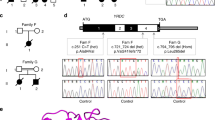Abstract
5-Oxoprolinuria (pyroglutamic aciduria)1,2 resulting from glutathione synthetase (GSS) deficiency3,4 is an inherited autosomal recessive disorder characterized, in its severe form, by massive urinary excretion of 5-oxoproline, metabolic acidosis, haemolytic anaemia and central nervous system damage. The metabolic defect results in low GSH levels presumably with feedback over-stimulation of γ-glutamylcysteine synthesis and its subsequent conversion to 5-oxoproline3,4. In this study, we cloned and characterized the human GSS gene and examined three families with four cases of well-documented 5-oxoprolinuria5,6. We identified seven mutations at the GSS locus on six alleles: one splice site mutation, two deletions and four missense mutations. Bacterial expression and yeast complementation assays of the cDNAs encoded by these alleles demonstrated their functional defects. We also characterized a fifth case, an homozygous missense mutation in the gene in an individual affected by a milder-form of the GSS deficiency7, which is apparently restricted to erythrocytes and only associated with haemolytic anaemia. Our data provide the first molecular genetic analysis of 5-oxoprolinuria and demonstrate that GSS deficiency with oxoprolinuria and GSS deficiency without 5-oxoprolinuria are caused by mutations in the same gene.
This is a preview of subscription content, access via your institution
Access options
Subscribe to this journal
Receive 12 print issues and online access
$209.00 per year
only $17.42 per issue
Buy this article
- Purchase on Springer Link
- Instant access to full article PDF
Prices may be subject to local taxes which are calculated during checkout
Similar content being viewed by others
References
Jellum, E., Kluge, T., Börresen, H.C., Stokke, O. & Eldjarn, L. Pyroglutamic aciduria — A new inborn error of metabolism. Scand. J. Clin. Lab. Invest. 26, 327–335 (1970).
Larsson, A. et al. 5-Oxoprolinuria due to hereditary 5-oxoprolinase deficiency in two brothers — A new inborn error of the γ-glutamyl cycle. Acta Pediat. Scand. 70, 301–308 (1981).
Larsson, A. Hereditary disorders in glutathione metabolism. in Glutathione: Metabolism and physiological functions (ed. Viña, J.) 359–366 (CRC Press, Boston, 1990).
Meister, A. & Larsson, A. Glutathione synthetase deficiency and other disorders of the γ-glutamyl cycle. in The Metabolic basis of inherited disease, 7th edn. (eds Beaudet, A.L., Scriver, C.R., Sly, W. S. & Valle, D.) 1461–1477 (McGraw-Hill, New York, 1995).
Spielberg, S.P. et al. 5-Oxoprolinuria: biochemical observations and case report. J. Pediat. 91, 237–241 (1977).
Jain, A., Buist, N.R.M., Kennaway, N.G., Powell, B.R., Auld, P.A.M. & Mårtensson, J. Effect of ascorbate or N-acetylcysteine treatment in a patient with hereditary glutathione synthetase deficiency. J. Pediat. 124, 229–233 (1994).
Mohler, D.N., Majerus, P.W., Minnich, V.M., Hess, C.E. & Garrick, M.D. Glutathione synthetase deficiency as cause of hereditary hemolytic disease. N. Engl. J. Med. 283, 1253–1257 (1970).
Shi, Z.-Z. et al. A single mouse glutathione synthetase gene encodes six mRNAs with different 5′ ends. Arch. Biochem. Biophys. 331, 215–222 (1996).
Gali, R.R. & Board, P.G. Sequencing and expression of a cDNA for human glutathione synthetase. Biochem. J. 310, 353–358 (1995).
Spielberg, S.P. et al. Biochemical heterogeneity in glutathione synthetase deficiency. J. Clin. Invest. 61, 1417–1420 (1978).
Larsson, A., Mattsson, B., Hagenfeldt, L. & Moldéu, P. Glutathione synthetase deficient human fibroblasts in culture. Clin. Chim. Acta 135, 57–64 (1983).
Astor, M.B. Radiobiological studies with a series of human cell lines of varying glutathione content. Br. J. Radiol. 57, 717–722 (1984).
Kavanagh, T.J. et al. Enhancement of glutathione content in glutathione synthetase-deficient fibroblasts from a patient with 5-oxoprolinuria via metabolic cooperation with normal fibroblasts. Exp. Cell Res. 212, 69–76 (1994).
Kozak, M. Structural features in eukaryotic mRNAs that modulate the initiation of translation. J. Biol. Chem. 266, 19867–19870 (1991).
Sachs, A.B. Messenger RNA degradation in eukaryotes. Cell 74, 413–421 (1993).
Mutoh, N., Nakagawa, C.W., Ando, S., Tanabe, K. & Hayashi, Y. Cloning and sequencing of the gene encoding the large subunit of glutathione synthetase of Schizosaccharomyces pombe. Biochem. Biophys. Res. Commun. 181, 430–436 (1991).
Mutoh, N. & Hayashi, Y. Isolation of mutants of Schizosaccharomyces pombe unable to synthesize cadystin, small cadmium-binding peptides. Biochem. Biophys. Res. Commun. 151, 32–39 (1988).
Beutler, E. Glutathione deficiency, pyroglutamic acidema and amino acid transport. N. Engl. J. Med. 295, 441–442 (1976).
Higuchi, R., Krummel, B. & Saiki, P.K. A general method of in vitro preparation and specific mutagenesis of DNA fragment: Study of protein and DNA intereactions. Nucl. Acids Res. 16, 7351–7367 (1988).
Meister, A. Glutathione synthetase from rat kidney. Meth. Enzymol. 113, 393–399 (1985).
Forsburg, S.L. Comparison of Schizosaccharomyces pombe expression systems. Nucl. Acids Res. 21, 2955–2956 (1993).
Majerus, P.W., Brauner, M.J., Smith, M.B. & Minnich, V. Glutathione synthesis in human erythrocytes: II. Purification and properties of the enzymes of glutathione biosynthesis. J. Clin. Invest. 50, 1637–1643 (1971).
Author information
Authors and Affiliations
Corresponding author
Rights and permissions
About this article
Cite this article
Shi, ZZ., Habib, G., Rhead, W. et al. Mutations in the glutathione synthetase gene cause 5–oxoprolinuria. Nat Genet 14, 361–365 (1996). https://doi.org/10.1038/ng1196-361
Received:
Accepted:
Issue Date:
DOI: https://doi.org/10.1038/ng1196-361
This article is cited by
-
Skeletal muscle and erythrocyte redox status is associated with dietary cysteine intake and physical fitness in healthy young physically active men
European Journal of Nutrition (2023)
-
Systems biology tools for toxicology
Archives of Toxicology (2012)
-
Alternative RNA splicing in expression of the glutathione synthetase gene in human cells
Molecular Biology Reports (2010)
-
Inborn errors in the metabolism of glutathione
Orphanet Journal of Rare Diseases (2007)
-
Genotype, enzyme activity, glutathione level, and clinical phenotype in patients with glutathione synthetase deficiency
Human Genetics (2005)



